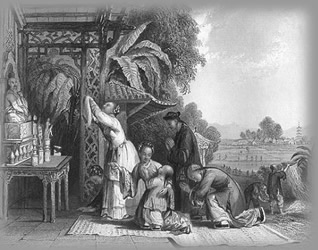 |
Sacrifice
of harvest moon (detail) Thomas Allom, China Illustrated (1843-7) |
The Chinese Mid-Autumn Festival—also known as the Full Moon Festival—occurs on the fifteen day of the eighth lunar month. At this time, the moon appears brighter and larger than at any other time of the year. Rising shortly after sunset, for a few days it gives farmers in the northern hemisphere an extra quota of light to bring in their crops; thus, in the West it is traditionally known as the Harvest Moon.
The Mid-Autumn Festival is in many ways similar to the Thanksgiving holiday celebrated in North America. It is a time of reunions, when families gather for a large communal feast. And in place of the Thanksgiving pumpkin pie, the special dish for this Chinese holiday is known as a mooncake: a flaked pastry stuffed with a wide variety of fillings such as egg yolk, lotus seed paste, red bean paste, coconut, walnuts and/or dates. Most of the pastries have the Chinese characters for longevity or harmony inscribed on the top; some specially prepared mooncakes can reach almost one foot in diameter.
In the 14th century, when revolutionaries were plotting to overthrow the Yuan Dynasty established by the Mongols, the Chinese used mooncakes as a means of dispersing covert information, safe in the knowledge that the Mongolian overlords did not share their enthusiasm for this very rich cake.
The Mid-Autumn Festival is observed in a variety of ways across China. Some places hold lantern processions; in others, spectators gather to witness the flood tide of local rivers during this most spectacular of full moons. And like many other harvest festivals altars are laden with thank offerings, such as in the illustration above from the 19th century artist Thomas Allom.